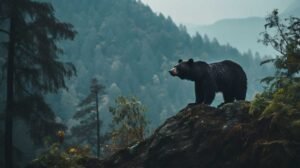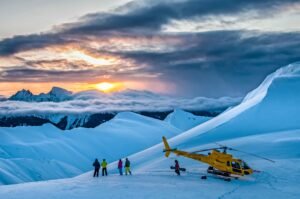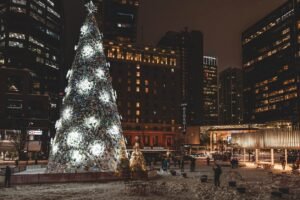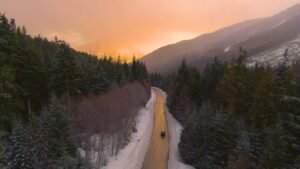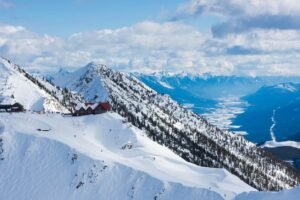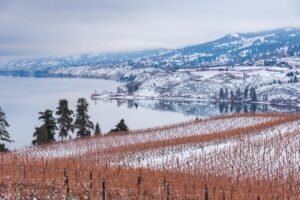Exploring the wilderness of British Columbia leads to encounters with some of the most iconic species on Earth, including the diverse British Columbia wildlife. This guide zeroes in on where to witness grizzlies, spot rare spirit bears, and observe orcas while emphasizing the critical conservation efforts that allow such experiences. Learn about the habitats, best times for sightings, and the importance of responsible wildlife tourism in British Columbia, all while appreciating the unique British Columbia wildlife.
Key Takeaways
-
The BC Wildlife Park offers immersive wildlife experiences such as grizzly bear feedings, and educational programs, also playing a critical role in animal rehabilitation, aiding over 500 animals annually.
-
The Great Bear Rainforest is a biodiverse sanctuary where one can witness rare species like the white-fur Spirit Bear and support eco-tourism initiatives through the Spirit Bear Lodge.
-
British Columbia provides exceptional marine wildlife viewing opportunities, including whale watching for orcas and humpbacks, and snorkelling with salmon in the Campbell River.
Majestic Grizzlies and More: The BC Wildlife Park Experience
The BC Wildlife Park, set across 106 acres, is a haven of wildlife nestled in the heart of British Columbia. Officially opened on August 16, 1966, the park is accredited by the Canadian Association of Zoos and Aquariums, a testament to its commitment to animal welfare and conservation. Visitors often find themselves enthralled by the various attractions and experiences the park has to offer, including:
-
Grizzly bear feedings
-
Wildlife encounters
-
Educational programs
-
Guided tours
-
Picnic areas
-
Playground
These experiences make a visit to the BC Wildlife Park a favorite among both locals and tourists alike.
The park boasts a unique Nature Exchange, where observation, research, and responsible collecting are encouraged. This initiative emphasizes respecting federal and provincial regulations, and instilling a sense of nature stewardship. Moreover, the park’s diverse educational sessions with animals serve as a testament to its efforts to promote sustainable environmental practices alongside wildlife education.
Despite financial hardships faced in 1970, the park continues to thrive, thanks to support from the regional district and an unwavering commitment to wildlife conservation.
Grizzly Bear Encounters
The park is home to two resident grizzly bears, Dawson and Knute, who have captivated visitors since they arrived in 2011. These magnificent creatures offer a unique window into the wild, allowing visitors to understand the importance of preserving the wildness of wildlife. The life stories of Dawson and Knute form a critical part of this learning experience, underscoring the need for coexistence with these incredible animals.
For the best chance to observe Dawson and Knute in their natural habitat, plan your visit early in the morning. The feeding sessions, which usually start at 09:30, present a captivating spectacle.
Rehabilitation Centre Insights
The BC Wildlife Park’s Fawcett Family Wildlife Health Centre is a beacon of hope for ailing wildlife. It is the only full-service wildlife rehabilitation facility in the Southern Interior. Every year, it provides crucial support to over 500 animals from across British Columbia. The center’s rehabilitation services cater to a wide spectrum of wildlife, including:
-
mammals
-
birds of prey
-
amphibians
-
reptiles
-
endangered species
The center’s dedication to wildlife also encompasses education. Together with Thompson Rivers University’s Animal Health Technology Program, they provide students a platform to participate in wildlife conservation, allowing them to gain practical experience in the field. The success stories of the center, such as the release of eight deer fawns back into the wild in 2008, illuminate the importance of the rehabilitation work carried out here.
Educational Adventures
The BC Wildlife Park’s commitment to education is embodied in its range of programs designed to inspire a love for nature in visitors of all ages. Young learners can participate in a preschool program featuring a 15-minute interactive animal encounter, a perfect way to foster early curiosity in wildlife.
The Wildlife Rangers Pin Program is another initiative aimed at encouraging children aged 5 to 13 to develop a passion for wildlife and wild spaces. For children aged 6 to 10, the park offers Kids Camps, packed with a day full of wildlife activities.
If in-person visits are not feasible, the park ensures learning carries on by offering virtual educational programs and encounters accessible from any location.
A Journey Through the Great Bear Rainforest
The Great Bear Rainforest, stretching across approximately 70,000 square kilometres along British Columbia’s coastline, is a sanctuary like no other. From the Discovery Islands to the Alaskan border, this untouched temperate rainforest is one of the world’s largest, teeming with an array of wildlife. The unique location of this rainforest, adjacent to both the Pacific Ocean and the interior mountains, provides an ideal habitat for diverse species, including:
-
black bears
-
grizzly bears
-
cougars
-
wolves
-
deer
-
beavers
For those seeking a glimpse of the elusive spirit bear, the months of September and October offer the best opportunities. Prime locations for sightings include Princess Royal Island and the coastal village of Klemtu.
Spirit Bear Mystique
The Spirit Bear, also known as the Kermode bear, is a unique subspecies of the black bear. It is characterized by a recessive genetic trait that gives it its distinctive white fur, making it a sight to behold. However, only about ten percent of Kermode bears exhibit this white fur, making the spirit bear an elusive creature.
These bears are native to the Great Bear Rainforest of British Columbia, the only place on earth where they can be found. Spotting a spirit bear in its natural habitat requires a blend of luck and persistence, but joining tours led by local cultural guides in areas like Klemtu can increase the chances of sightings.
Eco-Tourism Excellence
Tucked away in Klemtu, BC, within the Great Bear Rainforest, you will find the Spirit Bear Lodge. This eco-tourism venture is a community project owned and managed by the Kitasoo/Xai’xais First Nation. The lodge is a beacon of eco-tourism, employing 90% local staff and aiming to be 100% locally operated. Its commitment to sustainable practices extends to eliminating single-use plastics and using renewable energy sources.
The lodge also supports local conservation initiatives through a conservation fee included in package prices. Visitors are offered intimate wildlife encounters that adhere to ‘leave no trace’ principles, ensuring the preservation of natural habitats and behaviors. This unique approach to tourism allows visitors to:
-
Immerse in the wilderness without causing disruption to the environment or the wildlife
-
Support sustainable tourism
-
Contribute to local conservation efforts
Marine Majesty: Whale Watching in British Columbia
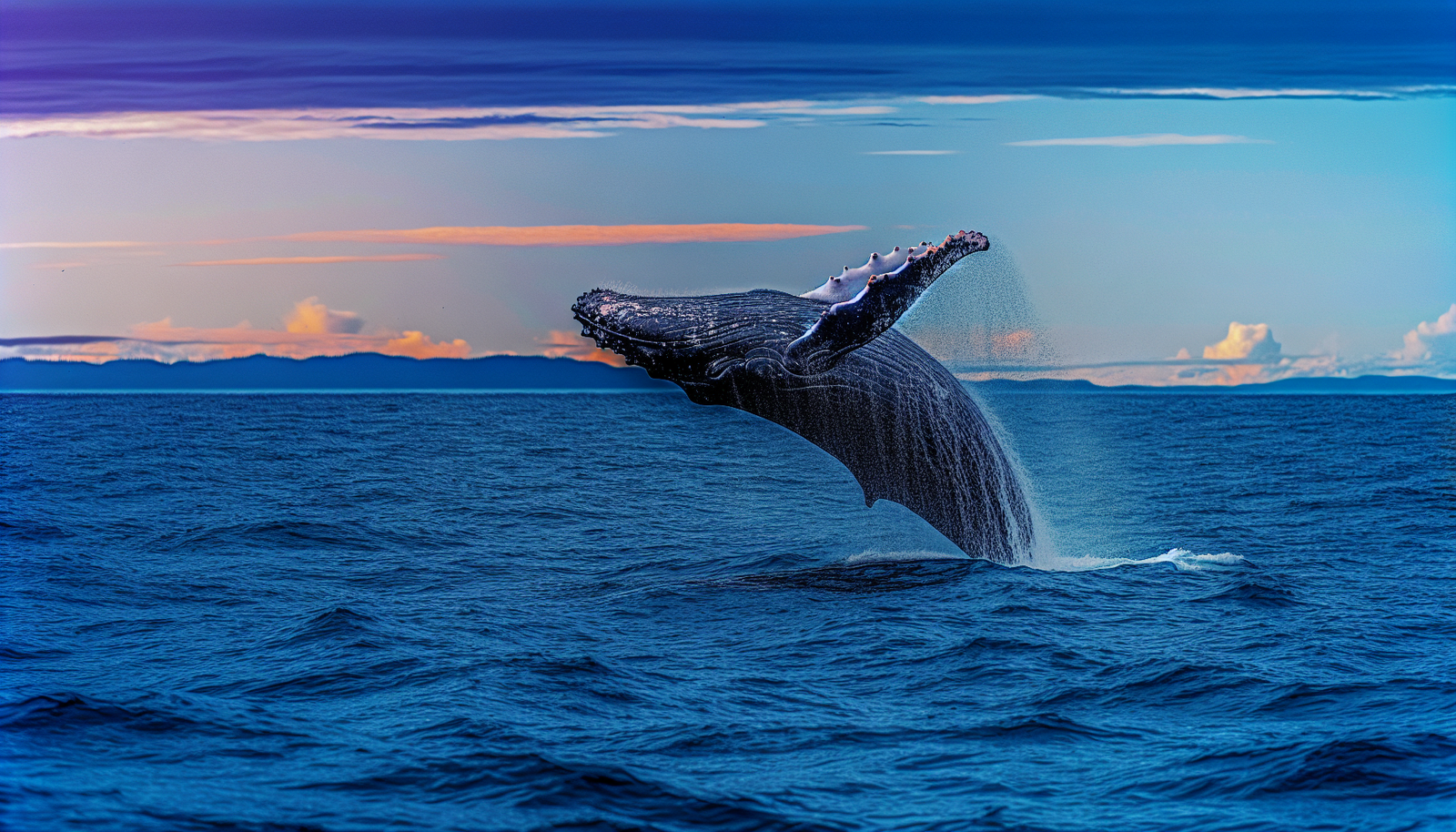
British Columbia’s marine majesty comes to life between May and October, the prime season for whale sightings. During this period, the waters off the coast of British Columbia became a playground for marine wildlife, with humpback whales, killer whales (orcas), and a diverse array of other marine species making their appearances.
Whether you’re an avid wildlife enthusiast or a casual traveller, the experience of seeing these mighty creatures up close is nothing short of awe-inspiring. The sight of a humpback whale breaching the surface or a pod of orcas gliding through the waves is a testament to the incredible biodiversity of this region, offering a marine spectacle that leaves an indelible impression.
Grey Whale Migration Marvels
From March to October, with the peak season spanning from mid-July to October, the waters of British Columbia become the stage for the spectacular migration of grey whales, as they travel from Baja California. Grey whales can often be encountered during whale-watching tours in the Strait of Juan de Fuca, thanks to a large resident whale population.
Locations like Tofino and Ucluelet in the Barkley Sound are renowned spots for observing grey whale pods, particularly when they come to feed. The Inside Passage near Prince Rupert also serves as a prime vantage point for grey whale sightings, especially from mid-July through October.
Orcas and Humpbacks Up Close
The areas of Johnstone Strait and the Broughton Archipelago are famed for their abundant orca populations. Approximately 200 orcas use these waters for feeding, making this region a hotspot for whale watchers. Whale-watching tours in areas like Telegraph Cove offer up to a 90% success rate for sightings from June to October, providing visitors with a high chance of spotting these incredible creatures.
These tours often include educational components, with information provided by expert guides and the Whale Interpretive Centre fostering a deeper understanding of marine ecosystems. Responsible whale watching is practiced by tours that enforce a minimum distance of 100 meters from whales. This approach contributes to the preservation of marine life and supports associated research and conservation initiatives.
Vancouver Island’s Wild Side
Vancouver Island, renowned as the ‘Salmon Capital of the World’, offers some of the most diverse and famous diving spots in the world. Once praised by Jacques Cousteau for their vibrancy, the waters around the island provide unique marine experiences that can’t be found anywhere else. The annual salmon runs, a spectacle that draws nature enthusiasts from around the world, occur from July to October, offering a grand display of nature’s intensity.
Five Pacific salmon species inhabit the island’s waters:
-
Steelhead
-
Coho
-
Pink
-
Chinook
-
Sockeye
Each species offers a unique spectacle, making every visit to Vancouver Island a new and exciting adventure.
Kayak with the Orcas
Telegraph Cove, conveniently located near Johnstone Strait, serves as an excellent launch site for kayaking excursions. It provides an opportunity to paddle amidst up to 300 killer whales that frequent the strait and Broughton Archipelago from July to September, as well as the chance to spot harbour seals in their natural habitat.
These memorable kayaking adventures offer a unique chance to observe orcas in their natural habitat. With both resident pods and migrating individuals commonly sighted, each trip provides a unique encounter with these magnificent creatures.
Snorkel the Salmon Run
The Campbell River offers an exhilarating snorkelling experience with thousands of salmon returning to spawn each fall, from July to November. Snorkelers can observe four types of Pacific salmon:
-
Pink Salmon between July and September
-
Chinook Salmon from October to November
-
Coho Salmon from October to November
-
Chum Salmon from late October to November
A typical snorkelling package includes a 7mm wetsuit, which provides not only warmth but also buoyancy, making it easier for snorkelers to float on the river’s surface. For a successful snorkelling experience, it’s recommended to use a buddy system, float with minimal movement, and be cautious of the surrounding fishermen.
High Country Habitats: Mountain Wildlife
The British Columbia mountains provide a distinct high-altitude habitat, hosting wildlife like moose, bighorn sheep, and mountain goats. The northern wilderness near Prince George is a frequented habitat for moose, with the best opportunities for sightings during their rutting season in late autumn, particularly September and October.
Conservation efforts are crucial for the preservation of these high country habitats and the protection of species such as moose, bighorn sheep, and mountain goats in British Columbia.
Bighorn Sheep and the Headbanger Festival
The rutting season for bighorn sheep in British Columbia occurs from late October to early December. During this period, the male sheep engage in impressive head-butting displays as they compete for mates. It’s important to remember that during the rutting season, bighorn sheep are particularly sensitive to disturbances. As such, wildlife officials remind spectators of the need for responsible viewing to minimize stress on the animals.
The Headbanger Festival is a celebration of this annual rutting season. The festival offers activities like sheep viewings, photography workshops, and guided hikes, offering a unique way to appreciate this natural phenomenon.
Moose and Mountain Goat Conservation
Moose populations in British Columbia face various challenges including habitat alteration, predation, and parasitic infestations. To address these challenges, the British Columbia government has developed management plans and guidelines to support sustainable moose populations. These plans include habitat management and regulated hunting to balance the ecosystem.
Mountain goats face pressures such as:
-
clearcut logging
-
road-building
-
wildfires
-
climate change
-
increased outdoor recreation activities
These factors contribute to their declining numbers. Approximately half of the world’s mountain goat population lives in British Columbia. Yet, recent surveys indicate a significant decrease in their numbers, highlighting the need for conservation intervention.
Burrowing Owl Conservation Efforts
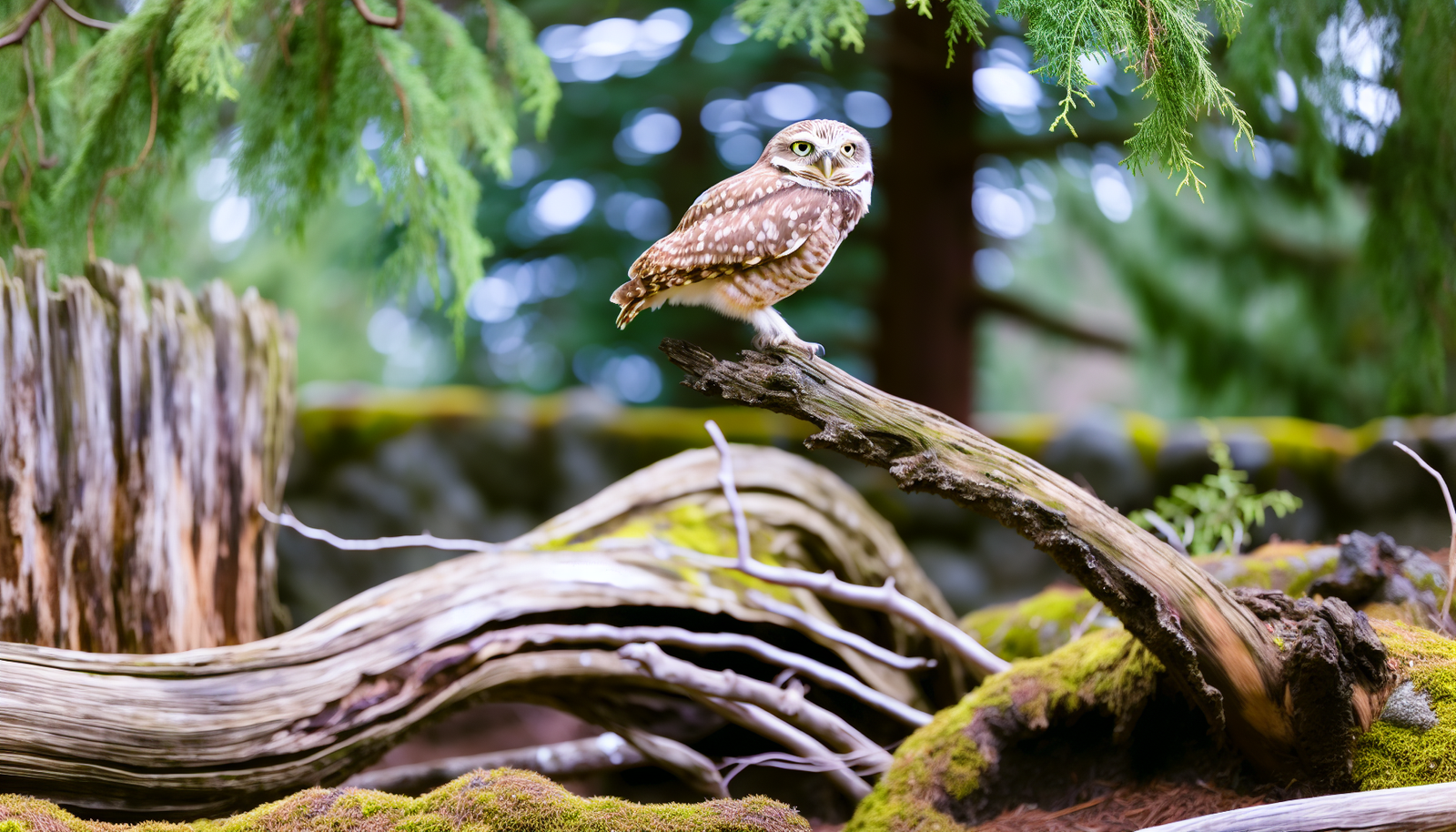
Since 1992, the BC Wildlife Park has emerged as a global leader in breeding burrowing owls, due in large part to its collaboration with the Burrowing Owl Conservation Society. The park’s captive breeding program has seen significant progress, from releasing 20 to over 50 owlets annually. To date, 1800 owls have been released, with over 2600 born in the wild.
The park’s commitment to burrowing owl conservation extends to habitat preservation. The Conservation Society places a strong emphasis on creating and maintaining artificial burrow systems in natural habitats. This initiative is crucial in light of diminishing native grasslands, ensuring a safe home for the owls.
Summary
From the grizzly bear encounters at the BC Wildlife Park to the salmon snorkelling experiences on Vancouver Island, the wildlife of British Columbia offers a multitude of captivating sights and experiences. Each encounter serves as a reminder of the intricate webs of life that make up our planet and the importance of protecting these natural habitats. So, whether you’re a seasoned naturalist or a budding wildlife enthusiast, British Columbia’s wildlife offers an open invitation to explore, learn, and marvel at the wonders of nature.
Frequently Asked Questions
What wildlife is found in British Columbia?
British Columbia is home to a diverse range of wildlife, including grizzly bears, orcas, herons, swans, and a variety of other bird and mammal species. With almost 500 bird species, 140 mammal species, and a range of reptiles, amphibians, and fish, the province offers a rich and varied wildlife experience.
What are the predators in British Columbia?
In British Columbia, some of the predators you might encounter include Coyotes, Grey Wolves, Black Bears, Grizzly Bears, and Cougars, among others. Stay informed and aware of wildlife in the area to stay safe.
What wildlife is Vancouver known for?
Vancouver is known for its diverse wildlife, including whales, bears, marmots, eagles, salmon, and trout. You’ll feel right at home if you love wildlife.
When is the best time to visit the BC Wildlife Park for grizzly bear sightings?
The best time to visit the BC Wildlife Park for grizzly bear sightings is early in the morning, during the scheduled feeding sessions at 09:30. You’ll have the best chance of observing the bears during this time.

